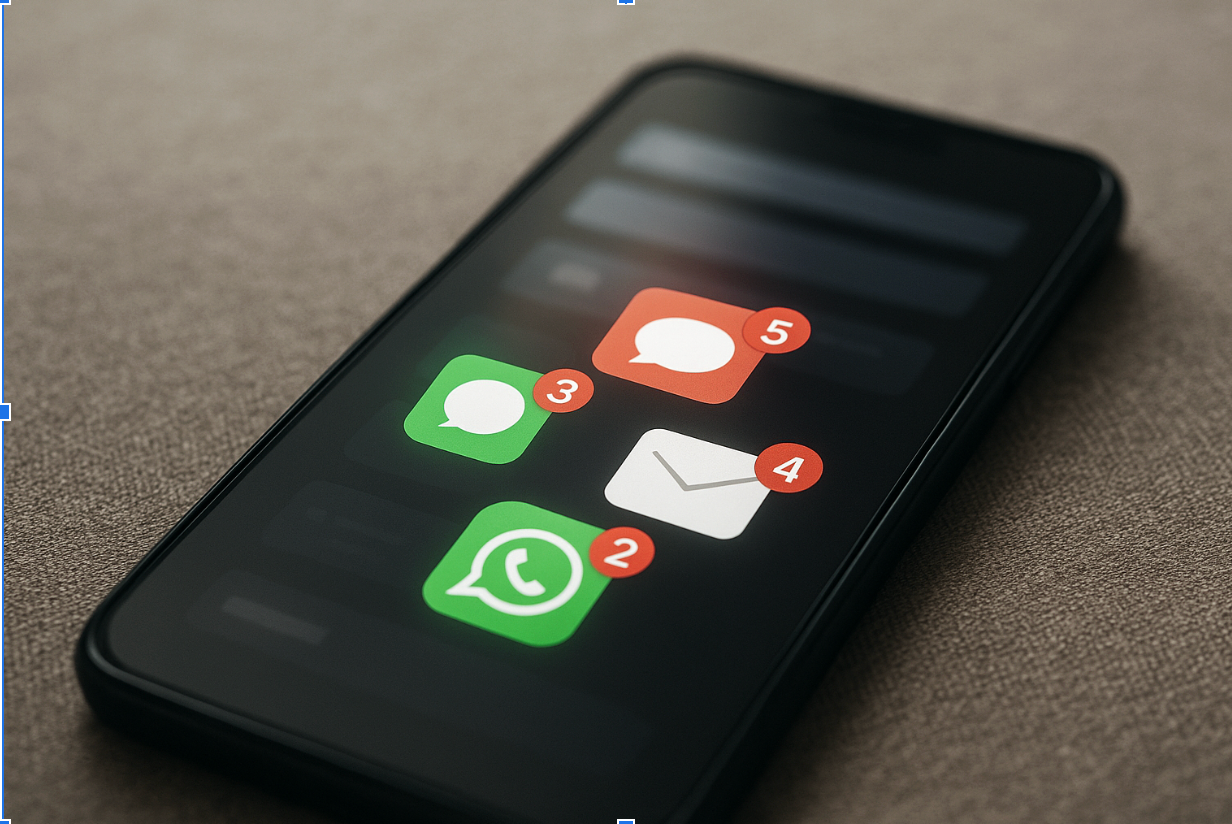
In today’s digital-first business environment, consumers are constantly exposed to marketing communications. From emails to social media ads, SMS marketing campaigns, and even WhatsApp marketing campaigns, brands are competing for attention like never before. While these efforts are essential for driving sales, they can also backfire if overused. This problem is known as message fatigue, a silent killer of customer engagement. Let us cover this topic thoroughly and help you avoid message fatigue completely.
Message Fatigue Definition
Understanding message fatigue and learning how to prevent it is critical if you want to create a successful SMS marketing campaign, maintain loyal customers, and ensure your marketing budget delivers the best return on investment. But before diving into strategies, it’s important to clarify the message fatigue definition. Simply put, message fatigue occurs when consumers become overwhelmed or annoyed by the volume, frequency, or repetitiveness of marketing communications. The result? Lower engagement rates, increased opt-outs, and a weakened brand connection.

Another way to look at the message fatigue definition is to see it as customer burnout. Just as people tire of hearing the same song on repeat, they tire of hearing the same promotions, reminders, or updates over and over. The third and perhaps most critical message fatigue definition is that it is the tipping point where communication ceases to inform or persuade and instead begins to irritate. Once a customer reaches this stage, recovery can be difficult.
When Do We Experience Message Fatigue?
So, when do we experience message fatigue? The answer is simple: during periods of high communication volume. Usually, they are holiday sales, product launches, or aggressive re-engagement campaigns. Customers may start by ignoring messages, then progress to actively unsubscribing or blocking the brand altogether. It often coincides with poorly planned campaign frequency, where messages are sent too often, without enough variation, or without considering the customer’s journey.
The Dangers of Messaging Fatigue
The consequences of messaging fatigue extend far beyond a single campaign’s underperformance. Persistent overcommunication can lead to brand fatigue, where customers not only ignore your messages but also lose interest in your products or services. Similarly, content fatigue can arise when messages lack freshness or originality. Customers may feel like they’ve “seen it all before,” diminishing their willingness to engage. Over time, these forms of marketing fatigue erode trust and reduce long-term customer loyalty.
SMS Marketing Frequency and Campaign Frequency
A major factor contributing to fatigue is SMS marketing frequency. While SMS is highly effective, boasting open rates of over 90%, its direct nature means it can quickly become intrusive. Brands must carefully balance how many messages are sent in a given timeframe. For example, sending three messages a day may work during a 24-hour flash sale but would likely cause irritation if done consistently. Proper SMS marketing frequency means aligning the number of texts with customer expectations and campaign goals.
Likewise, campaign frequency across all channels, such as email, WhatsApp, and push notifications, must be monitored. Customers don’t differentiate between platforms. If they feel overwhelmed by your brand in general, it’s irrelevant whether the message came by SMS, email, or app notification.
Avoiding Message Fatigue in SMS and WhatsApp Marketing Campaigns
- Segment Your Audience Not every customer needs every message. By segmenting based on preferences, purchase history, or engagement level, you can reduce unnecessary volume.
- Stagger Campaigns Coordinate your campaign frequency across channels. If a promotion has already been heavily featured in email, consider reducing the number of SMS reminders.
- Personalize Your Outreach Generic texts are more likely to cause irritation. Instead, write marketing text messages that convert by using personalization, urgency, and customer-specific offers.
- Adopt a Unified Messaging Inbox A unified messaging inbox consolidates all communication into one platform, giving marketers visibility into how often customers are being contacted. This helps prevent unintentional overlap that contributes to fatigue.
- Use Analytics to Monitor Engagement If open rates and click-through rates are dropping, it may be an early sign of messaging fatigue. Adjusting SMS marketing frequency or experimenting with timing can often resolve the issue.

Strategies to Refresh Content and Reduce Marketing Fatigue
- Diversify Message Types: Instead of constant discounts, share helpful tips, order updates, or loyalty rewards.
- Rotate Creative Assets: Swap out visuals, language, or offers to avoid content fatigue.
- Introduce Value Beyond Sales: Send holiday greetings, thank-you notes, or exclusive previews to reduce perceptions of pushy selling.
- Encourage Interaction: Quizzes, polls, or customer feedback requests can make communication feel less one-sided.
Building Sustainable Long-Term Engagement
To truly avoid message fatigue, businesses must treat communication as a relationship, not just a sales tactic. That means respecting customer preferences, offering genuine value, and being mindful of timing. The goal is to keep messages meaningful and balanced, ensuring they build excitement rather than exhaustion. This approach not only prevents brand fatigue but also increases the likelihood of repeat purchases and long-term loyalty.

By being intentional, you’ll not only avoid fatigue but also create a successful SMS marketing campaign that consistently drives results. And we can help you with that. We are TopMessage, and partnering with us makes it easier to create SMS marketing campaigns that drive long-term results. Our platform offers smart automation, personalization, and a unified messaging inbox. This way, you can manage communication without overwhelming customers. By balancing SMS marketing frequency and campaign frequency, we will help you avoid message fatigue. Also, to consistently write marketing text messages that convert, ensuring sustainable customer engagement.
Conclusion
Message fatigue is one of the greatest risks to modern digital marketing strategies. In an era where customers are constantly connected, over-communication can lead to disengagement, opt-outs, and even loss of brand trust. By carefully managing SMS marketing frequency, controlling overall campaign frequency, and leveraging tools like a unified messaging inbox, businesses can keep communications effective and respectful. Avoiding messaging fatigue requires a balance of personalization, segmentation, and thoughtful timing. Done well, your brand will not only maintain engagement but also strengthen long-term loyalty. And ultimately, when you write marketing text messages, you ensure that every communication counts.
FAQs
What is message fatigue?
Message fatigue occurs when customers feel overwhelmed by too many marketing messages, causing them to disengage or unsubscribe.
What is the message fatigue definition?
The message fatigue definition is the point where messages stop engaging and begin irritating, reducing their effectiveness.
When do we experience message fatigue?
When do we experience message fatigue? Typically, during high-volume periods like holiday sales or aggressive re-engagement efforts.
How does campaign frequency impact fatigue?
Excessive campaign frequency across SMS, email, and social media increases the risk of marketing fatigue, making customers less responsive.
What role does SMS marketing frequency play?
Improper SMS marketing frequency can quickly turn effective campaigns into intrusive annoyances. Moderation is key.
Can WhatsApp marketing campaigns also cause fatigue?
Yes, WhatsApp marketing campaigns are subject to the same risks if overused. Balance and personalization are crucial.
How can I prevent messaging fatigue?
Use segmentation, personalization, a unified messaging inbox, and balanced scheduling to reduce messaging fatigue.
What are brand fatigue and content fatigue?
Brand fatigue happens when customers tire of hearing from a company altogether, while content fatigue occurs when messaging lacks originality. Both reduce engagement.
How can I write marketing text messages that convert?
To write marketing text messages that convert, focus on personalization, clarity, urgency, and customer benefit.
How do I create a successful SMS marketing campaign?
To create a successful SMS marketing campaign, you must manage SMS marketing frequency, personalize content, and use data insights to optimize performance.